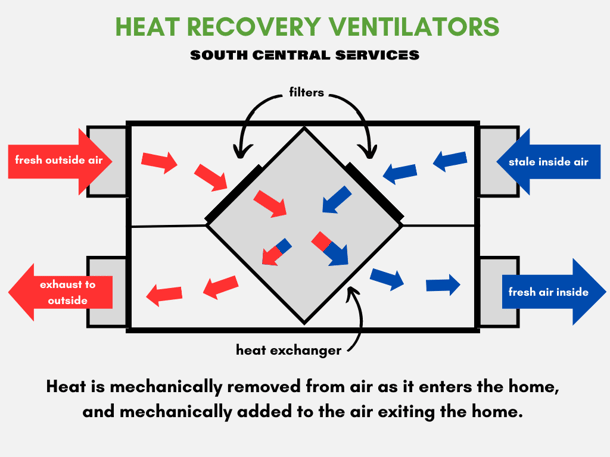How HRV Supports Indoor Air Quality and Better Breathing
Wiki Article
Exactly How Heat Recovery Ventilation Enhances Indoor Air Top Quality and Reduces Power Expenses
Heat Recovery Ventilation (HRV) systems play an important duty in boosting indoor air quality while simultaneously decreasing energy expenditures. By effectively exchanging stagnant interior air with fresh exterior air, HRVs help preserve ideal humidity and minimize toxins. Furthermore, their ability to recover warmth from outgoing air reduces the stress on heating and cooling systems. As power expenses remain to increase, recognizing the complete capacity of HRV systems comes to be progressively important for homeowners and organizations alike.Recognizing Heat Recovery Ventilation Solutions

Heat recovery ventilation (HRV) systems play a crucial duty in boosting indoor air quality, especially in modern, energy-efficient buildings. These systems are developed to move heat from the outgoing stagnant air to the incoming fresh air, consequently decreasing energy loss while maintaining suitable temperature levels inside. HRVs contain a heat exchanger, followers, and ductwork, facilitating the constant circulation of air. By eliminating indoor contaminants and introducing fresh air, HRVs assist to balance humidity degrees, protect against mold and mildew growth, and decrease irritants. The efficiency of HRV systems hinges on their ability to recover as much as 80% of the heat from the tired air, advertising power conservation while making certain a healthy and balanced interior atmosphere. Their integration is important in achieving sustainable living methods.
The Significance of Indoor Air Quality
Indoor air quality (IAQ) is a critical variable influencing the wellness and wellness of occupants in any kind of environment. Poor IAQ can lead to various health issues, including respiratory system problems, allergic reactions, and fatigue. Additionally, it can exacerbate status quo such as asthma. Elements adding to reduced IAQ include contaminants from interior sources like cleansing representatives, mold and mildew, and insufficient air flow. Preserving good IAQ is essential for promoting a risk-free and comfortable living or functioning space. Efficient methods to boost IAQ entail regular tracking of air high quality, proper ventilation systems, and lessening the usage of unsafe materials indoors. By prioritizing IAQ, people can assure a much healthier environment that cultivates performance and general top quality of life.Energy Performance Conveniences of HRV Equipments
Many house owners and structure managers are increasingly acknowledging the energy efficiency advantages of warm healing ventilation (HRV) systems. By transferring heat from exhausted interior air to inbound fresh air, HRV systems noticeably minimize the energy required for cooling and heating. This procedure reduces dependence on conventional HVAC systems, bring about reduced energy costs. In addition, HRVs help preserve a well balanced indoor environment, protecting against excessive heating or cooling needs. The ability to recuperate up to 90% of the heat from outgoing air also sustains sustainability efforts by reducing general power intake. Consequently, HRV systems contribute not just to set you back savings yet likewise to a lowered carbon footprint, straightening with the expanding emphasis on energy-efficient building methods.Setup and Upkeep Considerations
The effective application of warmth recuperation ventilation (HRV) systems requires mindful consideration of installment and maintenance factors to guarantee peak performance. Appropriate positioning of the HRV device is crucial, as it must be mounted in an area that optimizes airflow while reducing noise disruption. Additionally, ductwork should be suitably sized and insulated to avoid power loss. Routine upkeep, including filter substitute and system cleaning, is vital to safeguard ideal capability and indoor air quality. Proprietors need to establish a normal upkeep routine to recognize and attend to possible issues prior to they escalate. Collaboration with skilled professionals during both installment and maintenance phases can enhance the durability and efficiency of HRV systems, ultimately resulting in far better interior settings and minimized power prices.
Real-World Applications and Success Stories
Checking out real-world applications of warmth recuperation ventilation (HRV) systems discloses their substantial influence on interior air top quality and power performance throughout various setups. In property structures, property owners have reported better air quality, causing less allergic reactions and respiratory problems. Schools carrying out HRV systems have actually noted enhanced student focus and lowered absenteeism due to better ventilation. Commercial structures, such as offices and retail spaces, have actually experienced lower energy prices and raised worker productivity. A business workplace in a temperate environment accomplished a 30% decrease in energy bills after mounting an HRV system. These success stories demonstrate that HRV modern technology not only contributes to healthier atmospheres yet likewise offers tangible financial advantages, making it a beneficial financial investment for different markets.Often Asked Questions
Can HRV Equipments Minimize Allergens in Indoor Air?
The efficiency of HRV systems in minimizing indoor irritants mostly rests on their ability to filter and exchange air. HRV Heat Recovery Ventilation. By continually changing stale air, these systems can greatly lower irritant levels throughout interior atmospheres
Exactly How Does Moisture Affect HRV System Performance?
Moisture significantly influences HRV system efficiency; high levels can bring about condensation, lowering performance, while low moisture might boost air exchange. Stabilizing humidity is important for suitable procedure and keeping interior air quality.Are HRV Solutions Noisy During Operation?
HRV systems can generate differing noise degrees HRV Heat Recovery Ventilation during procedure, relying on their style and setup. Some devices operate silently, while others may produce visible audio, particularly at higher air flow setups or when inadequately preserved.What Is the Typical Life-span of an HRV System?

Can HRV Equipments Be Made Use Of in All Climates?
HRV systems can be used in numerous climates, but their efficiency might vary - HRV Heat Recovery Ventilation. In extreme temperature levels, adjustments or supplemental systems may be essential to guarantee ideal performance and convenience while maintaining interior air top qualityReport this wiki page